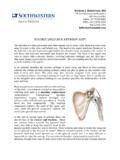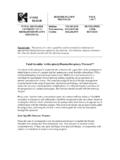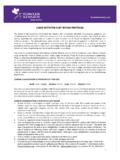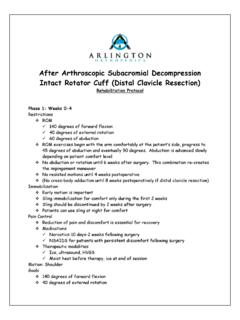Transcription of William J. Robertson, MD UT Southwestern …
1 Arthroscopic Rotator Cuff Repair postoperative Rehab Protocol Starting the first day after surgery you should remove the sling 3-4 times per day to perform pendulum exercises and elbow/wrist range of motion (unless otherwise specified by Dr. robertson ). You will follow-up with Dr. robertson 10 -14 days after surgery. At that office visit you will also see one of his physical therapist. Together they will customize a rehabilitation program based upon several factors ( tear size and tissue quality). At that time, they will help you schedule a physical therapy appointment at UTSW. Should you wish to perform therapy elsewhere, you should make arrangements to start therapy 1-3 days following this visit. This handout serves as a guideline for your rehabilitation after rotator cuff repair.
2 The speed in which you progress through these phases of rehab may be altered depending upon the size of your tear and the quality of the tissue. At your first post-op visit you will be given a copy of the operative report which will help the therapist guide your therapy appropriately. Shoulder surgery can be painful. You may have to sleep in a semi-erect position or in a recliner for several days. A pillow behind the operative shoulder and elbow can often provide relief. Please call Dr. robertson 's office if you are having a problem with your shoulder or need clarification regarding the rehab protocol. Typically, you may not remove the sling to drive for four weeks. This rehab protocol can be found at postoperative Phase I: Maximum Protection (Weeks 0 to 3) Goals Protect surgical repair Diminish pain and inflammation Gradually increase PROM Improve scapular and distal muscle strength Independence in home exercise program Precautions Maintain sling immobilization when not performing therapy exercises No active movements of the operated shoulder except for gentle self-care activities below the level of the shoulder Avoid exceeding ROM limitations set by the surgeon Avoid pain with ROM and isometric exercises General Principles Weight-bearing status: NWB Cryotherapy: C old therapy unit or ice used for first week and then PRN Sling.
3 At all times except for therapy exercises unless specified by the surgeon William J. robertson , MD UT Southwestern Orthopedics 1801 Inwood Rd. Dallas, TX 75390-8882 Office: (214) 645-3300 Fax: (214) 3301 Treatment Plan Education: sleeping postures, activity modifications Cryotherapy Pendulum exercises PROM shoulder exercises only PROM by rehab therapist No behind the back internal rotation Active range of motion exercises elbow/forearm/wrist/hand Scapular stabilization exercises side-lying (advance to manual resistance) Submaximal deltoid isometrics in neutral as ROM improves (short lever arm) Teach home exercise program Criteria for Progression to Phase II Normal Scapular mobility Full AROM distal to the shoulder postoperative Phase II.
4 Moderate Protection (Weeks 3 to 7) Goals Protect surgical repair Diminish pain and inflammation Improve ROM to 80 - 100% forward flexion and external rotation Improve periscapular strength and stability Improve scapulohumeral rhythm and neuromuscular control Decrease rotator cuff inhibition Precautions Avoid pain with ADLs Sling immobilization until discontinued by surgeon (typically four weeks for small/medium tears and six weeks with large/massive tears) Avoid active elevation of the operative arm No maximal cuff activation Avoid Pain with ROM/therapeutic exercises No excesses behind the back movements No supporting of body weight by the arms and hands Treatment Plan Continue exercises from phase I, progress ROM as tolerated Discontinue sling as directed by physician AAROM/PROM exercises AAROM exercises may begin at 4 weeks for small/medium tears (delay 6 weeks for large/massive tears) AAROM supine forward flexion using the contralateral upper extremity Supine ER/IR with wand in scapular plane May initiate pulleys (week 6) as ROM and muscle control improves.
5 (Delay for 8 weeks with large/massive tears.) May initiate pool program for light AROM exercises Physioball scapular stabilization (below the horizontal) Isometric exercises ER/IR (submaximal) at neutral to start at 6 weeks. (*May begin at 4 weeks for isolated supraspinatus tears with good tissue quality see op note) Progress deltoid isometrics to long lever arm in neutral Begin humeral head stabilization exercises as range of motion improves (>90 ) Modalities as indicated Modify home exercise program Criteria for Progression to Phase III Ability to activate cuff and deltoid without pain Tolerate arm out of sling ROM 80% or greater for forward flexion and external rotation postoperative Phase III: Early Strengthening (Weeks 7 to 13) Goals Eliminate/minimize pain and inflammation Restore full ROM Improve strength and flexibility Restore normal scapulohumeral rhythm below 90 elevation Gradually return to light ADLs below 90 elevation Precautions Monitor activity level Limit overhead activity Avoid shoulder shrug with activities and exercise Avoid jerky movements and lifting heavy objects Treatment Plan Continue cryotherapy PRN Continue wand exercises for ER/IR and flexion Flexibility exercises, adduction (posterior capsular stretching) Progress to functional ROM exercises (IR behind back)
6 Periscapular isotonic strengthening scapular protraction progress to scapular retraction exercises shoulder extension with theraband dumbbell rolling Rotator cuff isotonic strengthening exercises AROM, sidelying ER ER/IR modified neutral with therabands, if sufficient scapular strength (base) has developed Functional strengthening exercises AROM supine forward flexion in the scapular plane Progress to standing forward flexion Progress to rhythmic stabilization exercises Criteria for Progression to Phase IV Minimal pain and/or inflammation Full PROM Improved Rotator Cuff and Scapular Strength Normal scapulohumeral rhythm with shoulder elevations below 90 Independence with home exercise program postoperative Phase IV.
7 Late Strengthening (Weeks 14 to 19) Goals Improve (MMT) strength to 5/5 for scapular and shoulder musculature Improve neuromuscular control Normalize scapulohumeral rhythm throughout the full ROM Precautions Progress to overhead activity only when proper proximal stability has been achieved Treatment Plan Continue to progress isotonic strengthening for periscapular and rotator cuff musculature Latissimus pull-down Rowing machine Chest press Continue flexibility side-lying posterior capsular stretch Progress scapular stabilization program Initiate isokinetic strengthening (IR/ER) in scapular plane Initiate plyometric exercises below horizontal, if sufficient strength base May initiate interval golf program if appropriate (week 16) Criteria for Progression to Phase V Normalize scapulohumeral rhythm throughout the full ROM Normal (MMT) strength to 5/5 for scapular and shoulder musculature postoperative Phase V: Return to Sport (Weeks 20 to 24) Goals Maximize flexibility, strength, neuromuscular control to meet demands of sport Gradual return to recreational sport activities Gradual return to strenuous work activities Isokinetic testing.
8 85% of contralateral limb Independence in home and gym therapeutic exercise program for maintenance and progression of functional level at discharge Precautions Avoid pain with therapeutic exercise and activity Avoid sport activity until adequate strength, flexibility, and neuromuscular control Surgeons clearance needed for sport activity Treatment Plan Continue to progress isotonic strengthening for periscapular and rotator cuff musculature Continue flexibility and stabilization program Individualized program to meet demands of sport-specific requirements Plyometrics (above horizontal) Week 22: May progress golf program to playing golf (if appropriate) May initiate interval tennis program (if appropriate) May initiate swimming May initiate interval training program for pitchers and overhead athletes Criteria for Discharge Isokinetic testing close to normal ER/IR ratios (66%), 85% of contralateral Independence with home/gym program at discharge for maintenance and progression of flexibility, strength, and neuromuscular control Pendulum exercise Remove your sling, bend over at the waist and let the arm hang down.
9 Using your body to initiate movement, swing the arm gently forward and backward and in a circular motion. Make small radius (6 inch) circles. You can use a 12 inch floor tile or 8 x 11 piece of paper as a guide by placing your hand in the center and keeping it within the confines of the edges during the circular motion. Perform 10 circles in one direction then alternate (3 reps 3 times per day).











